
The Bantu languages are a language family of about 600 languages that are spoken by the Bantu peoples of Central, Southern, Eastern and Southeast Africa. They form the largest branch of the Southern Bantoid languages.
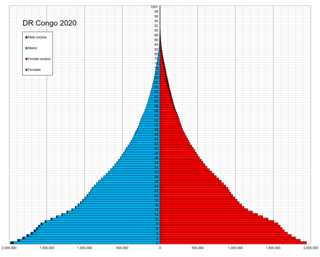
Demographic features of the population of the Democratic Republic of the Congo include ethnicity, education level, health, economic status, religious affiliations and other aspects of the population.
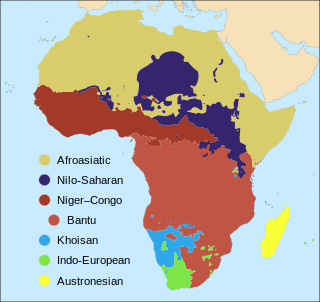
The number of languages natively spoken in Africa is variously estimated at between 1,250 and 2,100, and by some counts at over 3,000. Nigeria alone has over 500 languages, one of the greatest concentrations of linguistic diversity in the world. The languages of Africa belong to many distinct language families, among which the largest are:

Lingala (Ngala) is a Bantu language spoken in the northwest of the Democratic Republic of the Congo, the northern half of the Republic of the Congo, in their capitals, Kinshasa and Brazzaville, and to a lesser degree in Angola, the Central African Republic, Kenya and southern South Sudan. Lingala has 25–30 million native speakers and about 35 million second-language speakers, for an approximate total of 60–65 million speakers.

The Democratic Republic of the Congo is a country in Central Africa. By land area, the DRC is the second-largest country in Africa and the 11th-largest in the world. With a population of around 112 million, the Democratic Republic of the Congo is the most populous Francophone country in the world. The national capital and largest city is Kinshasa, which is also the economic center. The country is bordered by the Republic of the Congo, Central African Republic, South Sudan, Uganda, Rwanda, Burundi, Tanzania, Zambia, Angola, the Cabinda exclave of Angola, and the South Atlantic Ocean.
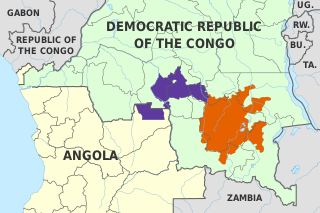
Luba-Kasai, also known as Cilubà or Tshilubà, Luba-Lulua, is a Bantu language of Central Africa and a national language of the Democratic Republic of the Congo, alongside Lingala, Swahili, and Kikongo ya leta.

Bandundu is one of eleven former provinces of the Democratic Republic of the Congo. It bordered the provinces of Kinshasa and Bas-Congo to the west, Équateur to the north, and Kasai-Occidental to the east. The provincial capital is also called Bandundu.
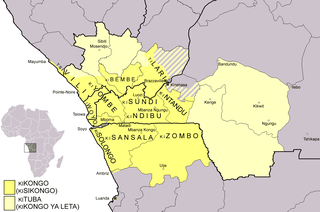
Kongo or Kikongo is one of the Bantu languages spoken by the Kongo people living in the Democratic Republic of the Congo (DRC), the Republic of the Congo, Gabon, and Angola. It is a tonal language. The vast majority of present-day speakers live in Africa. There are roughly seven million native speakers of Kongo in the above-named countries. An estimated five million more speakers use it as a second language.
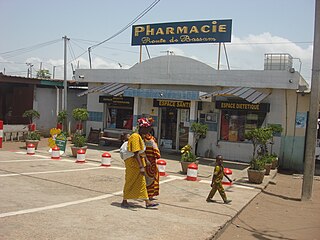
African French is the generic name of the varieties of the French language spoken by an estimated 167 million people in Africa in 2023 or 51% of the French-speaking population of the world spread across 34 countries and territories. This includes those who speak French as a first or second language in these 34 African countries and territories, but it does not include French speakers living in other African countries. Africa is thus the continent with the most French speakers in the world, and African French speakers now form a large and integral part of the Francophonie.

The culture of the Democratic Republic of the Congo is extremely varied, reflecting the great diversity and different customs which exist in the country. Congolese culture combines the influence of tradition to the region, but also combines influences from abroad which arrived during the era of colonization and continue to have a strong influence, without destroying the individuality of many tribal customs.

Kasaï-Oriental is one of the 21 new provinces of the Democratic Republic of the Congo created in the 2015 repartitioning. Kasaï-Oriental, Lomami, and Sankuru provinces are the result of the dismemberment of the former Kasaï-Oriental province. Kasaï-Oriental was formed from the Tshilenge district and the independently administered city of Mbuji-Mayi which retained its status as a provincial capital.
Lodja is a remote town in the Sankuru province in central Democratic Republic of the Congo. It is serviced by the Lodja Airport which is about 7 kilometres (4.3 mi) from town. Lodja is a hub for both rice production in the province and diamond mining in the country. Lodja is and has been home to many Tetela.

Portuguese is the only official language of Angola, but 46 other languages are spoken in the country, mostly Bantu languages.
Kituba is a widely used lingua franca in Central Africa. It is a creole language based on Kikongo, a Bantu language. It is a national language in Republic of the Congo and Democratic Republic of the Congo.
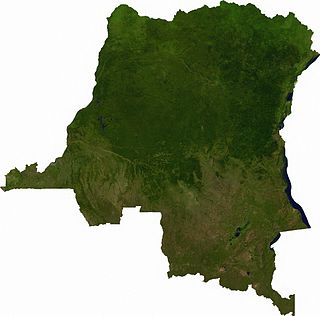
Articles related to the Democratic Republic of the Congo include:

Luba-Katanga, also known as Luba-Shaba and Kiluba, is a Bantu language of Central Africa. It is spoken mostly in the south-east area of the Democratic Republic of the Congo by the Luba people.

Radio Okapi is a radio network that operates in the Democratic Republic of the Congo. On an annual budget of USD$4.5 million, a staff of 200 provide news and information to the entire urban population of the DRC. Radio Okapi provides programming in French and in the four national languages of Congo: Lingala, Kituba, Swahili and Tshiluba,

Mass media in the Democratic Republic of the Congo are both nationally and internationally state owned and operated.

The official language of the Republic of Congo is French. Other languages are mainly Bantu languages, and the two national languages in the country are Kituba and Lingala, followed by Kongo languages, Téké languages, and more than forty other languages, including languages spoken by Pygmies, which are not Bantu languages.

Katanda Territory is one of five territories which, along with the city of Mbuji-Mayi, constitute the current Congolese province of Kasai-Oriental. The Democratic Republic of the Congo (DRC) is made up of 192 territories and 20 cities which are grouped in 26 provinces including Kinshasa, the capital city. Katanda Territory is sectioned into four sectors: Baluba-Lubilanji, Mutwayi, Nsangu, and Tshitolo. The territory is also endowed with three towns. Katanda Town is the headquarters of both Katanda Territory and Baluba-Lubilanji Sector as well; this town is located on the top of the hill in the Bena Nshimba Grouping. Tshala town, in the Bakwa Ndaba Grouping, is also famous because of its power station on the Tshala River that supplies power to Mbuji-Mayi city and its neighborhoods. So, Tshitenge Town which is well known for its diamond businesses is in the Bena Nshimba Grouping.


















